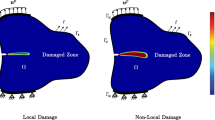Abstract
This paper presents the research into the implementation of the viscoelastic continuum damage model (VCDM) of asphalt concrete into a finite element analysis. The VCDM is based on: (1) the elastic-viscoelastic correspondence principle using pseudostrains; (2) the work potential theory for damage modeling; and (3) the time-temperature superposition principle with growing damage. With the aid of Schapery's preceding work, the VCDM is implemented in a three-dimensional setting. The resulting material model was implemented in the commercially available finite element program, ABAQUS. Results from constant crosshead rate monotonic tension tests at varying temperatures and strain rates were used to verify the finite element model. Verification results are promising when the viscoelastic response dominates the behavior. However, at high temperatures and/or slow strain rates, the effect of the viscoplastic response in the mixture was found to be important and warrants the incorporation of the viscoplastic model for an accurate response prediction.
Similar content being viewed by others

References
Daniel, J.S. and Kim Y.R. (2002). “Development of a simplified fatigue test and analysis procedure using a viscoelastic continuum damage model.”Journal of Association of Asphalt Paving Technologists (to be published).
Ghehab, R.G. (2002).Characterization of Asphalt Concrete in Tension Using a Viscoelastoplastic Model, Dissertation, North Carolina State University.
Ghehab, G.R., Kim, Y.R., Schapery, R.A., Witczak, M.W., and Bonaquist, R. (2002). “Time-temperature superposition principle for asphalt concrete mixtures with growing damage in tension.”Journal of Association of Asphalt Paving Technologists (to be published).
Ha, K. and Schapery, R.A. (1998). “A three-dimensional viscoelastic constitutive model for particulate composites with growing damage and its experimental validation.”International Journal of Solids and Structures, Vol. 35, pp. 3497–3517.
Hibbit, Karlsson and Sorenson, Inc. (2001).ABAQUS User's Manual, Hibbit, Karlsson and Sorenson, Inc.
Hinterhoelzl, R. (2000).Implementation of an Umat for Solid Propellant in the FEM Program Abaqus According to the Constitutive Law, Research Report, University of Texas at Austin.
Kaliske, M. and Rothert, H. (1997). “Formulation and implementation of three-dimensional viscoelasticity at small and finite strains.”Computational Mechanics, Vol. 19, pp. 228–239.
Kim, Y.R., Lee, H.J., and Little, D.N. (1997). “Fatigue characterization of asphalt concrete using viscoelasticity and continuum damage theory.”Journal of the Association of Asphalt Paving Technologists, Vol. 66, pp. 520–569.
Park, S.W., Kim, Y.R., and Schapery, R.A. (1996). “A viscoelastic continuum damage model and its application to uniaxial behavior of asphalt concrete.”Mechanics of Material, Vol. 24, pp. 241–255.
Park, S. W. and Schapery, R.A. (1997). “A viscoelastic constitutive model for particulate composite with growing damage.”International Journal of Solids and Structures, Vol. 34, pp. 931–947.
Poon, H. and Ahmad, M.F. (1998). “A material point time integration procedure for anisotropic, thermo rheologically simple, viscoelastic solids.”Computational Mechanics, Vol. 21, pp. 236–242.
Schapery, R.A. (1984). “Correspondence principles and a generalized J integral for large deformation and fracture analysis of viscoelastic media.”International Journal of Fracture, Vol. 25, pp. 195–223.
Schapery, R.A. (1990). “Theory of mechanical behavior of elastic media with growing damage and other changes in structure.”Journal of the Mechanics and Physics of Solids, Vol. 38, pp. 215–253.
Schapery, R.A. (1991). “Analysis of damage growth in particulate composites using a work potential.”Composite Engineering, Vol. 60, pp. 153–173.
Simo, J.C. and Hughes, T.J.R. (1998).Computational Inelasticity. Springer-Verlag, New York.
Taylor, R.L., Pister, K.S., and Goudrequ, G.L. (1970). “Thermomechanical analysis of viscoelastic solids.”International Journal for Numerical Methods in Engineering, Vol. 2, pp. 45–59.
Zocher, M.A., Groves, S.E., and Allen, D.H. (1997). “A three-dimensional finite element formulation for thermoviscoelastic orthotropic media.”International Journal of Numerical Methods in Engineering, Vol. 40, pp. 2267–2288.
Author information
Authors and Affiliations
Corresponding author
Rights and permissions
About this article
Cite this article
Mun, S., Guddati, M.N. & Kim, Y.R. Continuum damage finite element modeling of asphalt concrete. KSCE Int. J Civ Eng 9, 205–211 (2005). https://doi.org/10.1007/BF02829051
Received:
Accepted:
Issue Date:
DOI: https://doi.org/10.1007/BF02829051



